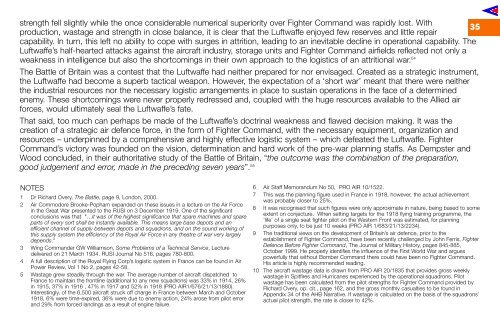THE ROYAL AIR FORCE - Air Power Studies
THE ROYAL AIR FORCE - Air Power Studies
THE ROYAL AIR FORCE - Air Power Studies
You also want an ePaper? Increase the reach of your titles
YUMPU automatically turns print PDFs into web optimized ePapers that Google loves.
strength fell slightly while the once considerable numerical superiority over Fighter Command was rapidly lost. With<br />
production, wastage and strength in close balance, it is clear that the Luftwaffe enjoyed few reserves and little repair<br />
capability. In turn, this left no ability to cope with surges in attrition, leading to an inevitable decline in operational capability. The<br />
Luftwaffe’s half-hearted attacks against the aircraft industry, storage units and Fighter Command airfields reflected not only a<br />
weakness in intelligence but also the shortcomings in their own approach to the logistics of an attritional war. 54<br />
The Battle of Britain was a contest that the Luftwaffe had neither prepared for nor envisaged. Created as a strategic instrument,<br />
the Luftwaffe had become a superb tactical weapon. However, the expectation of a ‘short war’ meant that there were neither<br />
the industrial resources nor the necessary logistic arrangements in place to sustain operations in the face of a determined<br />
enemy. These shortcomings were never properly redressed and, coupled with the huge resources available to the Allied air<br />
forces, would ultimately seal the Luftwaffe’s fate.<br />
That said, too much can perhaps be made of the Luftwaffe’s doctrinal weakness and flawed decision making. It was the<br />
creation of a strategic air defence force, in the form of Fighter Command, with the necessary equipment, organization and<br />
resources – underpinned by a comprehensive and highly effective logistic system – which defeated the Luftwaffe. Fighter<br />
Command’s victory was founded on the vision, determination and hard work of the pre-war planning staffs. As Dempster and<br />
Wood concluded, in their authoritative study of the Battle of Britain, “the outcome was the combination of the preparation,<br />
good judgement and error, made in the preceding seven years”. 55<br />
35<br />
NOTES<br />
1 Dr Richard Overy, The Battle, page 9, London, 2000.<br />
2 <strong>Air</strong> Commodore Brooke-Popham expanded on these issues in a lecture on the <strong>Air</strong> Force<br />
in the Great War presented to the RUSI on 3 December 1919. One of the significant<br />
conclusions was that "…it was of the highest significance that spare machines and spare<br />
parts of every sort shall be instantly available. This means large base depots and an<br />
efficient channel of supply between depots and squadrons, and on the sound working of<br />
this supply system the efficiency of the Royal <strong>Air</strong> Force in any theatre of war very largely<br />
depends."<br />
3 Wing Commander GW Williamson, Some Problems of a Technical Service, Lecture<br />
delivered on 21 March 1934. RUSI Journal No 516, pages 780-800.<br />
4 A full description of the Royal Flying Corp’s logistic system in France can be found in <strong>Air</strong><br />
<strong>Power</strong> Review, Vol 1 No 2, pages 42-58.<br />
5 Wastage grew steadily through the war. The average number of aircraft dispatched to<br />
France to maintain the frontline (additional to any new squadrons) was 33% in 1914, 26%<br />
in 1915, 37% in 1916 , 47% in 1917 and 52% in 1918 (PRO <strong>AIR</strong>1/676/21/13/1880).<br />
Interestingly, of the 6,500 aircraft struck off charge in France between March and October<br />
1918, 6% were time-expired, 36% were due to enemy action, 24% arose from pilot error<br />
and 29% from forced landings as a result of engine failure.<br />
6 <strong>Air</strong> Staff Memorandum No 50, PRO <strong>AIR</strong> 10/1522.<br />
7 This was the planning figure used in France in 1918, however, the actual achievement<br />
was probably closer to 25%.<br />
8 It was recognised that such figures were only approximate in nature, being based to some<br />
extent on conjecture. When setting targets for the 1918 flying training programme, the<br />
‘life’ of a single seat fighter pilot on the Western Front was estimated, for planning<br />
purposes only, to be just 10 weeks (PRO <strong>AIR</strong> 1/683/21/13/2234).<br />
9 The traditional views on the development of Britain’s air defence, prior to the<br />
establishment of Fighter Command, have been recently challenged by John Ferris, Fighter<br />
Defence Before Fighter Command, The Journal of Military History, pages 845-885,<br />
October 1999. He properly identifies the influence of the First World War and argues<br />
powerfully that without Bomber Command there could have been no Fighter Command.<br />
His article is highly recommended reading.<br />
10 The aircraft wastage data is drawn from PRO <strong>AIR</strong> 20/1835 that provides gross weekly<br />
wastage in Spitfires and Hurricanes experienced by the operational squadrons. Pilot<br />
wastage has been calculated from the pilot strengths for Fighter Command provided by<br />
Richard Overy, op. cit., page 162, and the gross monthly casualties to be found in<br />
Appendix 34 of the AHB Narrative. If wastage is calculated on the basis of the squadrons’<br />
actual pilot strength, the rate is closer to 42%.

















